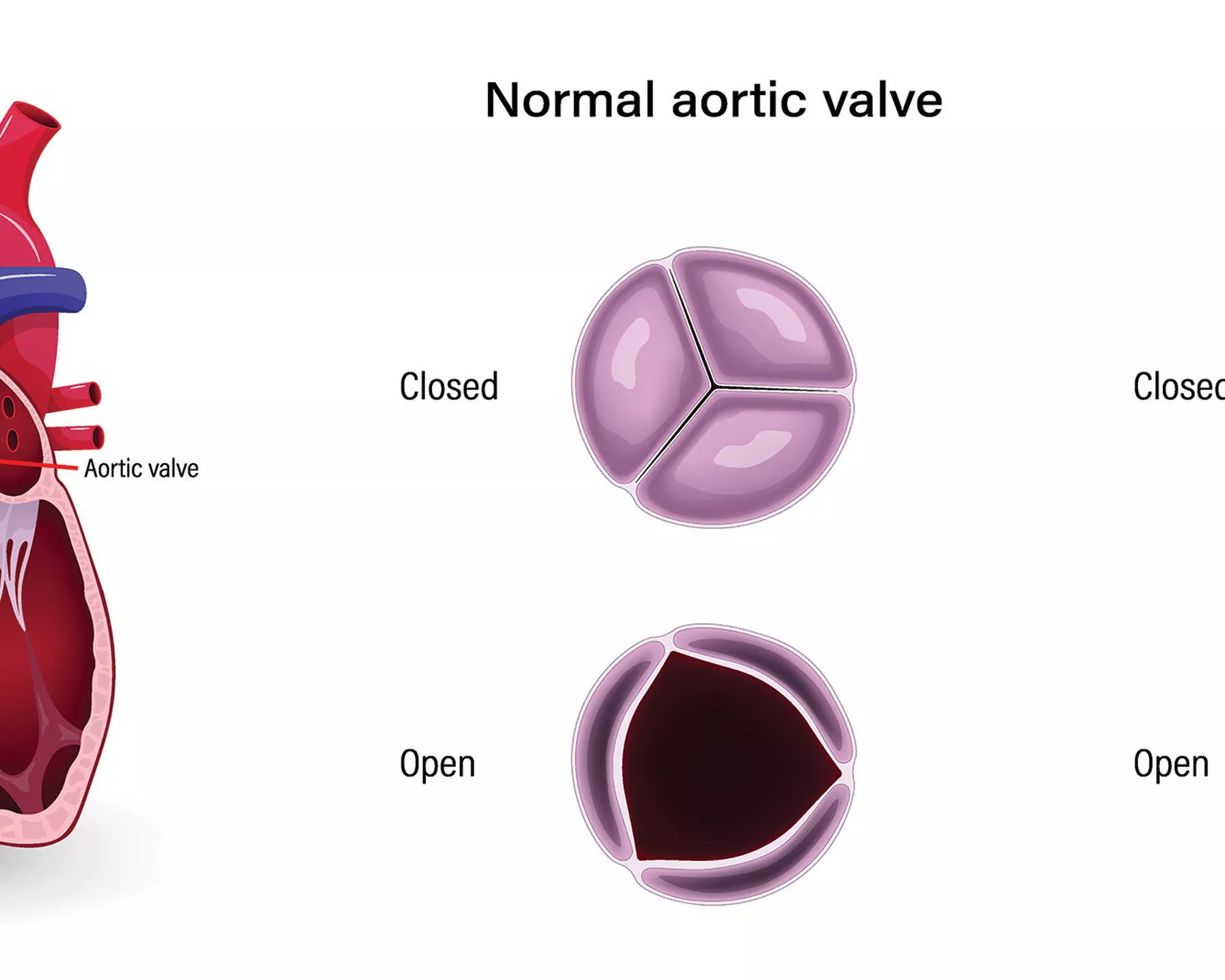What is aortic stenosis?
Aortic stenosis is a heart condition affecting the aortic valve. Also known as ‘AS’, the condition can be serious and lead to complications like heart failure.
AS is a narrowing of the aortic valve, which restricts the blood flow from the left ventricle to the aorta and around the rest of the body.
This means the heart is overloaded and can no longer pump blood efficiently around the body. It may also create high pressure inside the left ventricle.
AS is a progressive disease that can cause thickening of the heart muscle and stiffening.
Types of aortic stenosis
The condition is classified according to its severity: mild, moderate or severe – depending how damaged your aortic valve is and the amount of blood still able to pass through.
Mild aortic stenosis
Many people who have a mild case of AS may not notice any symptoms. The most common early warning signs include feeling tired or needing to exert more effort than usual during a physical activity.
As a result, most people only find out about mild AS during a check-up. When a doctor listens to your heart, they may hear a ‘murmur’ – or an abnormal sound between heartbeats.
Moderate aortic stenosis
As the condition progresses, the aortic valve’s opening starts to shrink further and the heart muscle has to work harder.
Some people may start to notice symptoms such as fatigue, shortness of breath, chest pain, lightheadedness or fainting. However, moderate cases of AS can still go unnoticed.
Severe aortic stenosis
Over time, the aortic valve’s opening becomes extremely narrowed and causes even more strain on the heart. However, some patients with severe AS can still have no symptoms.
If left untreated, severe AS can lead to heart failure, intense fatigue, shortness of breath, and swelling of your ankles and feet. In severe cases, repair or replacement of the aortic valve is often necessary.
Causes of aortic stenosis
The main causes of AS are:
Ageing: As people get older, their heart valve can become hardened and scarred due to the build-up of calcium. This is the most common cause of AS in older people. Age-related AS usually begins after age 60, but often doesn’t show symptoms until ages 70 or 80.
Congenital heart defect: Some people are born with abnormalities of the aortic valve. This can cause the valve to narrow and thicken.
Rheumatic heart disease: This is a less common cause of AS, but a condition caused by acute rheumatic fever can scar the aortic valve and narrow its opening.
Risk factors for aortic stenosis
Risk factors for AS include:
- smoking
- having high blood pressure
- having high cholesterol
- having chronic kidney disease
- having radiation therapy to the chest.
Symptoms of aortic stenosis
It is important to note that you may or may not experience symptoms of AS, depending on the severity of the condition.
The most common symptoms include:
- Shortness of breath – this begins at first as just shortness of breath with exercise, but in severe AS can occur even when you are lying down or resting
- Pain in your chest (angina)
- Tightness in your chest when exercising
- Feeling faint or dizzy and even blacking out or collapsing
- Fatigue
- Irregular heartbeat – a rapid or fluttering feeling in your chest.
Diagnosing aortic stenosis
Your doctor will ask you questions to assess your risk factors and perform a physical examination.
They will listen to your heart with a stethoscope, and if a murmur is detected an echocardiogram will be performed to confirm if you have AS.
Treating aortic stenosis
Once diagnosed, your treatment plan will be determined based on the severity of your condition.
If there are no symptoms or in mild cases, your doctor may suggest monitoring and regular check-ups.
Other possible treatment options include medications, valve repair or valve replacement.
Surgical procedures for aortic stenosis
Surgery options for AS include:
- Surgical aortic valve replacement (SAVR)
If the aortic valve is too damaged to be repaired, it may be surgically replaced with an artificial or tissue valve. This is a type of open heart surgery known as aortic valve replacement. Sometimes, the person’s own lung (pulmonary) valve may be used. This is known as the Ross procedure.
- Transcatheter aortic valve implantation (TAVI)
This procedure involves a new valve being inserted inside the heart through keyhole surgery. It is a less invasive approach to SAVR and done via small catheters. It usually means a shorter stay in hospital than for those who go through SAVR and is preferred for people who are at high risk of complications from invasive surgery.
- Balloon valvuloplasty
In this procedure, a catheter with a balloon on the tip is inserted into an artery in the arm or groin and guided to the aortic valve. Once in place, the balloon is inflated to stretch the valve opening. The balloon is then deflated, and the catheter and balloon are removed. Balloon valvuloplasty is usually used as a temporary measure in infants and children.
When to seek medical advice for aortic stenosis
See your doctor straight away if you have symptoms that come on when you are active, including:
- shortness of breath
- feeling faint or fainting
- chest pain.
Long-term prognosis of aortic stenosis
When left untreated, severe AS is associated with high mortality rates and poor long-term survival.
A recent review study in The Lancet found that patients with severe AS had typically high five-year mortality.
A 2021 study by Australian researchers, published in the Journal of American College of Cardiology, also suggested poor survival rates in patients with moderate AS.
However, with timely and appropriate treatment, outcomes are improved.
Complications of aortic stenosis
AS can be a serious and potentially life-threatening condition.
Some of the possible complications include:
- Heart failure: Without treatment, AS can cause heart failure, where the heart is not able to pump blood and oxygen around the body as well as it should.
- Irregular or abnormal heart rhythm (arrhythmia): Changes in the shape and size of the heart due to AS can cause an irregular heartbeat. Some abnormal heart rhythms can be life-threatening and need urgent treatment.
- Build-up of fluid in the lungs (pulmonary oedema): AS causes increased pressure in the left ventricle, which can also increase pressure in the blood vessels of the lungs and cause breathing difficulties.
- Enlarged heart (cardiomegaly): Without treatment, AS can cause the left ventricle to thicken and enlarge, reducing its ability to pump blood around the body. The heart enlarges to try to adapt to the increased pressure.
- Stroke: When fragments of the calcified aortic valve break loose, these fragments can cause a stroke if they get lodged in the brain’s circulation.
- Death: Sudden cardiac death (SCD) is a risk in patients with severe, symptomatic AS, particularly when surgery is not performed promptly.
Ways to manage aortic stenosis
There is no cure for AS, but there are certain lifestyle changes you can make to help manage and prevent it.
This includes:
Keeping your heart healthy: High blood pressure, obesity, and high cholesterol levels may be linked to AS. In consultation with your healthcare professional, take steps to lead a heart-healthy lifestyle by:
- Controlling your blood pressure through dietary changes such as lowering salt intake or medication
- Eating a healthy diet and getting regular exercise to help maintain a healthy weight
- Managing cholesterol levels through medication and dietary changes.
Maintaining good oral hygiene: Infected gums can cause inflammation of heart tissue that can aggravate AS.
Aortic stenosis and your quality of life
If you are diagnosed with AS, you can still live a full and rewarding life. You will need to be monitored by a heart specialist and follow their treatment plan.
With the right treatment, including the minimally invasive TAVI surgery, those with severe AS can see a remarkable improvement in quality of life.
Common questions about aortic stenosis
Being diagnosed with a heart condition like AS can be challenging, and you may have many questions.
Here are some you may like to discuss with your doctor or other healthcare professional, to get advice specific to your situation.
- What is the likelihood my symptoms will get worse?
- Will making changes to my diet and lifestyle help?
- How often do I need to visit a doctor to monitor my condition?
- Is there medication that can help?
- Do I need to restrict my physical activity?
- Is it better to get a new heart valve or repair the damaged one?
- Are some people too old to undergo a valve replacement?
- Will I need open heart surgery to replace the valve or are there other options?
- What risks are involved in heart valve replacement?
- Will I be cured after getting a new valve?
How is HRI fighting aortic stenosis?
HRI is investigating new ways to prevent, detect and treat cardiovascular diseases and heart conditions like AS from a variety of different angles.
Our Cardiovascular-protective Signalling and Drug Discovery Group is investigating how to repurpose existing drugs for next-generation therapies for cardiovascular diseases.
Our Clinical Research Group is conducting research into congenital heart disease (CHD), with a focus on young adults living with CHD and heart defects that could lead to conditions like AS. Research conducted by the group includes projects designed to improve quality of life and exercise capacity for people living with CHD; improve health outcomes in CHD for young adults, their families and the health system; and establish a unique National Congenital Heart Disease Registry.



